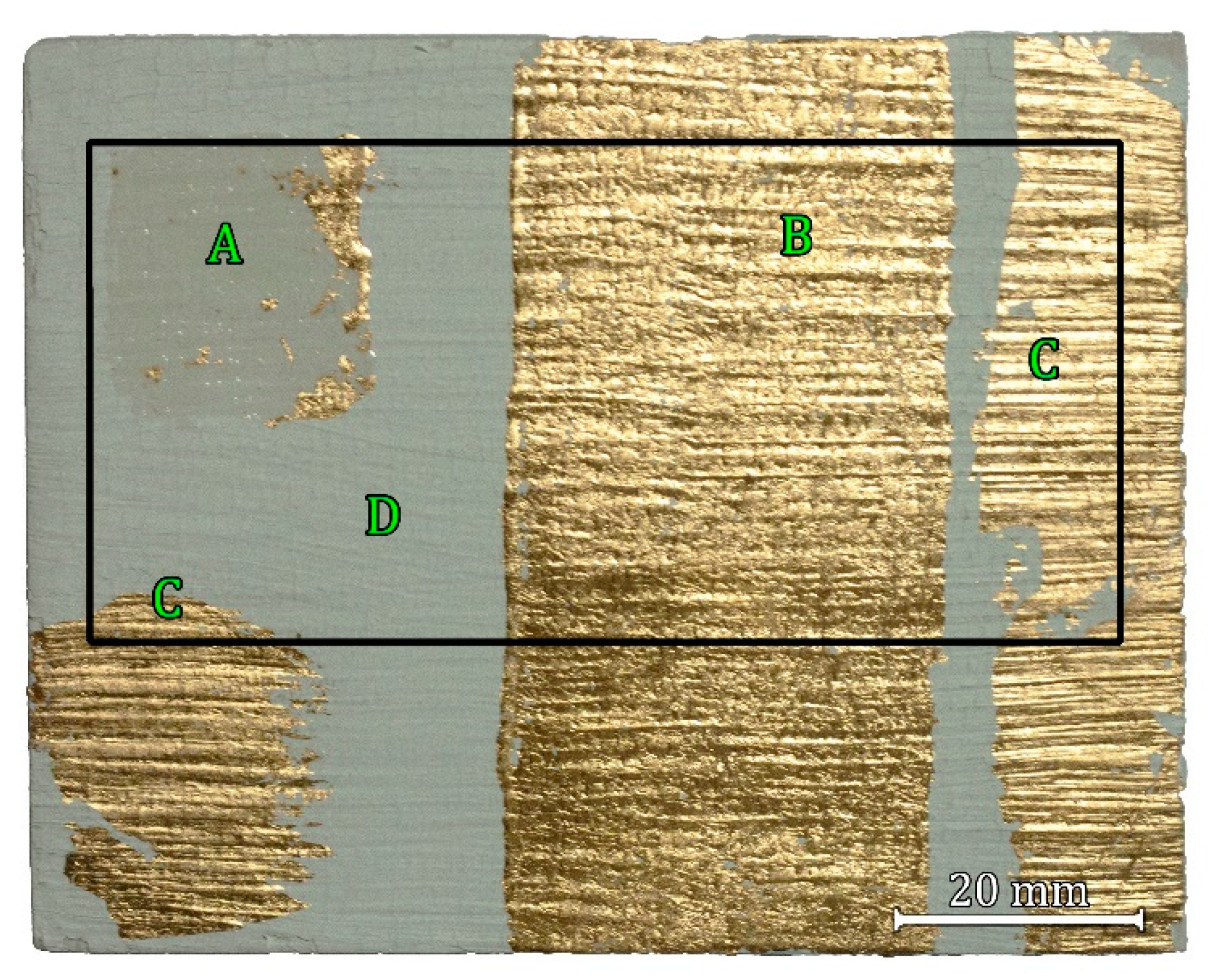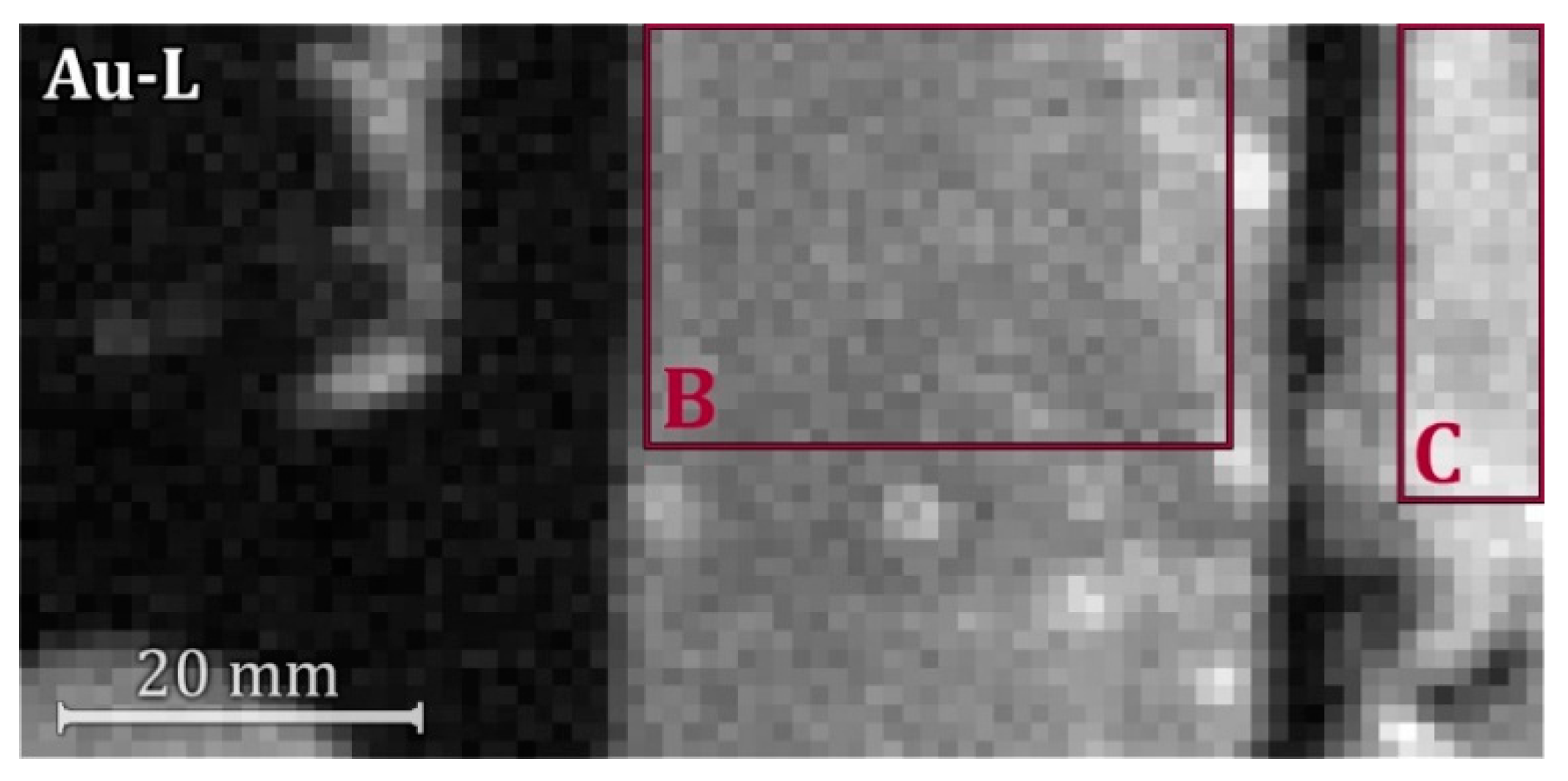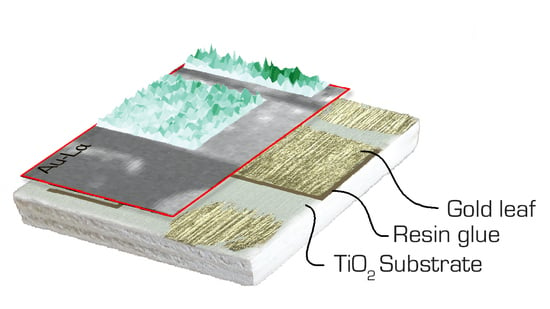Testing the Accuracy of the Calculation of Gold Leaf Thickness by MC Simulations and MA-XRF Scanning
Abstract
:Featured Application
Abstract
1. Introduction
2. Materials and Methods
2.1. Sample Preparation
2.2. Monte Carlo Simulations
2.3. MA-XRF Scanning
3. Thickness Determination
3.1. Peak Area Calculation
3.2. Differential Attenuation
4. Results and Discussion
5. Conclusions
Author Contributions
Funding
Conflicts of Interest
References
- Giurlani, W.; Berretti, E.; Innocenti, M.; Lavacchi, A. Coating Thickness Determination Using X-ray Fluorescence Spectroscopy: Monte Carlo Simulations as an Alternative to the Use of Standards. Coatings 2019, 9, 79. [Google Scholar] [CrossRef] [Green Version]
- Cesareo, R. Non-destructive EDXRF-analysis of the golden haloes of Giotto’s frescos in the Chapel of the Scrovegni in Padua. Nucl. Instrum. Methods Phys. Res. B 2003, 211, 133–137. [Google Scholar] [CrossRef]
- Ridolfi, S. Gilded copper studied by non-destructive energy-dispersive X-ray fluorescence. Insight Non-Destr. Test. Cond. Monit. 2018, 60, 37–41. [Google Scholar] [CrossRef]
- Ingo, G.M.; Riccucci, C.; Pascucci, M.; Messina, E.; Giuliani, C.; Biocca, P.; Tortora, L.; Fierro, G.; di Carlo, G. Combined use of FE-SEM+EDS, ToF-SIMS, XPS, XRD and OM for the study of ancient gilded artefacts. Appl. Surf. Sci. 2018, 446, 168–176. [Google Scholar] [CrossRef]
- Lopes, F.; Melquiades, F.L.; Appoloni, C.R.; Cesareo, R.; Rizzutto, M.; Silva, T.F. Thickness determination of gold layer on pre-Columbian objects and a gilding frame, combining pXRF and PLS regression. X-Ray Spectrom. 2016, 45, 344–351. [Google Scholar] [CrossRef]
- Ager, F.J.; Ferretti, M.; Grilli, M.L.; Juanes, D.; Ortega-Feliu, I.; Respaldiza, M.A.; Roldán, C.; Scrivano, S. Reconsidering the accuracy of X-ray fluorescence and ion beam based methods when used to measure the thickness of ancient gildings. Spectrochim. Acta Part B At. Spectrosc. 2017, 135, 42–47. [Google Scholar] [CrossRef]
- Ingo, G.M.; Guida, G.; Angelini, E.; di Carlo, G.; Mezzi, A.; Padeletti, G. Ancient mercury-based plating methods: Combined use of surface analytical techniques for the study of manufacturing process and degradation phenomena. Acc. Chem. Res. 2013, 46, 2365–2375. [Google Scholar] [CrossRef]
- Cesareo, R.; Rizzutto, M.A.; Brunetti, A.; Rao, D.v. Metal location and thickness in a multilayered sheet by measuring Kα/Kβ, Lα/Lβ and Lα/Lγ X-ray ratios. Nucl. Instrum. Methods Phys. Res. B 2009, 267, 2890–2896. [Google Scholar] [CrossRef]
- Nardes, R.C.; Silva, M.S.; Rezier, A.N.S.; Sanches, F.A.C.R.A.; Gama Filho, H.S.; Santos, R.S.; Oliveira, D.F.; Lopes, R.T.; Carvalho, M.L.; Cesareo, R.; et al. Study on Brazilian 18th century imperial carriage using X-ray nondestructive techniques. Radiat. Phys. Chem. 2019, 154, 74–78. [Google Scholar] [CrossRef]
- Cesareo, R.; Bustamante, A.D.; Fabian, J.S.; del Pilar Zambrano, S.; Alva, W.; Chero, L.Z.; del Carmen Espinoza, M.C.; Rodriguez, R.R.; Seclen, M.F.; Gutierrez, F.V.; et al. Multilayered artifacts in the pre-Columbian metallurgy from the North of Peru. Appl. Phys. A Mater. Sci. Process. 2013, 113, 889–903. [Google Scholar] [CrossRef]
- Cesareo, R.; Bustamante, A.; Fabian, J.; Calza, C.; dos Anjos, M.; Lopes, R.T.; Elera, C.; Shimada, I.; Curay, V.; Rizzutto, M.A. Energy-dispersive X-ray fluorescence analysis of a pre-Columbian funerary gold mask from the Museum of Sicán, Peru. X-Ray Spectrom. 2010, 39, 122–126. [Google Scholar] [CrossRef]
- Cesareo, R.; Buccolieri, G.; Castellano, A.; Lopes, R.T.; de Assis, J.T.; Ridolfi, S.; Brunetti, A.; Bustamante, A. The structure of two-layered objects reconstructed using EDXRF-analysis and internal X-ray ratios. X-Ray Spectrom. 2015, 44, 233–238. [Google Scholar] [CrossRef]
- Brunetti, A.; Fabian, J.; la Torre, C.; Schiavon, N. A combined XRF/Monte Carlo simulation study of multilayered Peruvian metal artifacts from the tomb of the Priestess of Chornancap. Appl. Phys. A Mater. Sci. Process. 2016, 122, 571. [Google Scholar] [CrossRef]
- Campos, P.H.O.V.; Appoloni, C.R.; Rizzutto, M.A.; Leite, A.R.; Assis, R.F.; Santos, H.C.; Silva, T.F.; Rodrigues, C.L.; Tabacniks, M.H.; Added, N. A low-cost portable system for elemental mapping by XRF aiming in situ analyses. Appl. Radiat. Isot. 2019, 152, 78–85. [Google Scholar] [CrossRef] [PubMed]
- Saverwyns, S.; Currie, C.; Lamas-Delgado, E. Macro X-ray fluorescence scanning (MA-XRF) as tool in the authentication of paintings. Microchem. J. 2018, 137, 139–147. [Google Scholar] [CrossRef]
- Ruberto, C.; Mazzinghi, A.; Massi, M.; Castelli, L.; Czelusniak, C.; Palla, L.; Gelli, N.; Betuzzi, M.; Impallaria, A.; Brancaccio, R.; et al. Imaging study of Raffaello’s "La Muta" by a portable XRF spectrometer. Microchem. J. 2016, 126, 63–69. [Google Scholar] [CrossRef]
- Cesareo, R.; Lopes, R.T.; Gigante, G.E.; Ridolfi, S.; Brunetti, A. First results on the use of a EDXRF scanner for 3D imaging of paintings. Acta Imeko 2018, 7, 8–12. [Google Scholar] [CrossRef]
- Barcellos Lins, S.A.; Ridolfi, S.; Gigante, G.E.; Cesareo, R.; Albini, M.; Riccucci, C.; di Carlo, G.; Fabbri, A.; Branchini, P.; Tortora, L. Differential X-Ray Attenuation in MA-XRF Analysis for a Non-invasive Determination of Gilding Thickness. Front. Chem. 2020, 8. [Google Scholar] [CrossRef] [PubMed]
- Brunetti, A.; Golosio, B.; Schoonjans, T.; Oliva, P. Use of Monte Carlo simulations for Cultural Heritage X-ray fluorescence analysis. Spectrochim. Acta Part B At. Spectrosc. 2015, 108, 15–20. [Google Scholar] [CrossRef]
- Cennini, C. The Craftsman’s Handbook (Il Libro dell’Arte); Dover: Mineola, NY, USA, 1933. [Google Scholar]
- Brunetti, A.; Sanchez Del Rio, M.; Golosio, B.; Simionovici, A.; Somogyi, A. A library for X-ray-matter interaction cross sections for X-ray fluorescence applications. Spectrochim. Acta Part B At. Spectrosc. 2004, 59, 1725–1731. [Google Scholar] [CrossRef]
- Brunetti, A.; Golosio, B. A new Monte Carlo code for simulation of the effect of irregular surfaces on X-ray spectra. Spectrochim. Acta Part B At. Spectrosc. 2014, 94–95, 58–62. [Google Scholar] [CrossRef]
- Golosio, B.; Schoonjans, T.; Brunetti, A.; Oliva, P.; Masala, G.L. Monte Carlo simulation of X-ray imaging and spectroscopy experiments using quadric geometry and variance reduction techniques. Comput. Phys. Commun. 2014, 185, 1044–1052. [Google Scholar] [CrossRef] [Green Version]
- van Grieken, R.E.; Markowicz, A.A. Handbook of X-ray Spectrometry; Marcel Dekker, Inc.: New York, NY, USA, 2002. [Google Scholar]
- Cesareo, R. X-Ray Physics: Interaction with matter, production, detection. La Rivista Del Nuovo Cimento Della Scoietà Italiana Di Fisica 2000, 23, 231. [Google Scholar] [CrossRef] [Green Version]
- Cesareo, R.; de Assis, J.T.; Roldán, C.; Bustamante, A.D.; Brunetti, A.; Schiavon, N. Multilayered samples reconstructed by measuring Kα/K β or Lα/Lβ X-ray intensity ratios by EDXRF. Nucl. Instrum. Methods Phys. Res. B 2013, 312, 15–22. [Google Scholar] [CrossRef]







| Average Gilding Thickness (μm) | ||||
|---|---|---|---|---|
| Sample | With Resin | Without Resin | ||
| Mean | Std. deviation | Mean | Std. deviation | |
| Simulated Sample | 0.35 μm | 0.01 μm | 0.19 μm | 0.01 μm |
| Real Sample* | 0.16 μm | 0.09 μm | 0.23 μm | 0.13 μm |
© 2020 by the authors. Licensee MDPI, Basel, Switzerland. This article is an open access article distributed under the terms and conditions of the Creative Commons Attribution (CC BY) license (http://creativecommons.org/licenses/by/4.0/).
Share and Cite
Barcellos Lins, S.A.; Gigante, G.E.; Cesareo, R.; Ridolfi, S.; Brunetti, A. Testing the Accuracy of the Calculation of Gold Leaf Thickness by MC Simulations and MA-XRF Scanning. Appl. Sci. 2020, 10, 3582. https://doi.org/10.3390/app10103582
Barcellos Lins SA, Gigante GE, Cesareo R, Ridolfi S, Brunetti A. Testing the Accuracy of the Calculation of Gold Leaf Thickness by MC Simulations and MA-XRF Scanning. Applied Sciences. 2020; 10(10):3582. https://doi.org/10.3390/app10103582
Chicago/Turabian StyleBarcellos Lins, Sergio Augusto, Giovanni Ettore Gigante, Roberto Cesareo, Stefano Ridolfi, and Antonio Brunetti. 2020. "Testing the Accuracy of the Calculation of Gold Leaf Thickness by MC Simulations and MA-XRF Scanning" Applied Sciences 10, no. 10: 3582. https://doi.org/10.3390/app10103582








